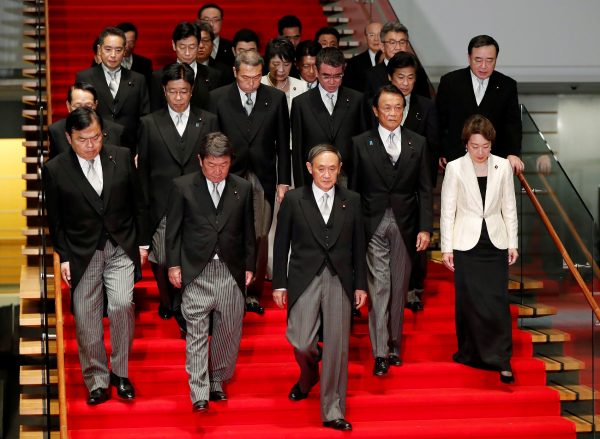This theme of continuity resonated with the LDP’s key powerbrokers. As they looked ahead to the next general election, which must be held by October 2021, they sought to ward off party infighting and avoid a return to the pre-Abe merry-go-round prime ministership. Suga was seen as the person who could most credibly claim to represent stability amid the COVID-19 crisis. He was also seen as the best man to carry the torch on Abe’s economics policy package, Abenomics, which was a key factor in the LDP’s six national election victories in a row since 2012.
Yet Suga’s victory might never have been without the support of Toshihiro Nikai. An octogenarian LDP stalwart from Wakayama and a former minister of economy, trade and industry in the Koizumi and Fukuda governments, Nikai recently became the LDP’s longest serving secretary general (kanjicho).
Nikai has long played the role of kingmaker. Nikai ensured the longevity of the Abe government by changing LDP party rules in 2017, which allowed Abe to become Japan’s longest serving prime minister. After Abe decided to resign, Nikai moved quickly — with the help of the 75-year old Hiroshi Moriyama, the longest serving chairperson of the Diet Affairs Committee — to guarantee Suga’s victory. Nikai first persuaded the leaders of the LDP’s three biggest factions (the Hosoda, Aso and Takeshita factions) that Suga was the right man for the job.
Nikai then used his powers as LDP kanjicho to limit the vote for the new LDP president to sitting LDP MPs plus three party representatives from each of the 47 prefectures. This cut the LDP’s one million rank-and-file members out of the process and snuffed out the chances of Fumio Kishida and trenchant Abe critic Shigeru Ishiba.
It is unusual that Nikai has such political clout in the LDP given he left the party between 1993–2003. Nikai even survived a behind-the-scenes challenge from Kishida for LDP kanjicho during the 2019 cabinet reshuffle.
The continued influence of Nikai as a key party backroom fixer has three key implications.
First, the LDP continues to be controlled by familiar old-guard figures. Suga became the first non-faction and non-dynasty LDP leader. But given his own lack of a factional base, Suga has prioritised the factional balance of power in his cabinet and risks undercutting transformative policymaking. The Suga cabinet (including only two female ministers) has failed to incorporate fresh faces that look capable of respond to contemporary policy challenges. The key quartet now in control of the LDP have an average age of 71.5 years. The LDP’s retirement age of 73 for MPs only applies to politicians winning their seat through proportional list votes — not those elected from single-member districts.
Assuming Suga intends to stay in power beyond September 2021 when LDP rules require a regular full-scale leadership election, he is likely to look for a victory to extoll on his declared agenda, such as digitalisation and mobile phone price-cuts. Suga would then rely on Nikai and Moriyama to help smooth over internal LDP opposition before calling a snap election to position himself ahead of other challengers.
Second, as the Suga government determines how it will balance COVID-19 infection prevention measures and economic revitalisation, including the controversial ‘Go To’ travel campaign to promote domestic tourism, Nikai might be tapped to play a bridging role between Suga and Tokyo Governor Yuriko Koike.
Frosty relations between Suga and Koike worsened after Suga criticised Tokyo’s mismanagement of COVID-19 for jeopardising the ‘Go To’ campaign, and Koike responded by raising Tokyo’s COVID-19 alert to the highest level, leading to the temporary exclusion of Tokyo from the program. Despite Nikai’s support for the ‘Go To’ campaign due to his role as the chair of the All Nippon Travel Agents Association, he is thought to maintain goodwill with Koike thanks to his role in moving the LDP’s Tokyo chapter to support Koike’s gubernatorial re-election campaign in July.
What sort of balance Nikai might seek to strike remains uncertain. He seems to place priority on national resilience and preventing and mitigating national disasters, a line of thought which stems from his late political mentor Kakuei Tanaka. With a continuing pandemic and Japan’s exposure to natural disasters, political stability between central and local governments matters, especially in preparation for the postponed Tokyo Olympic Games.
Third, with Nikai a well-known proponent of Sino-Japanese engagement, the Suga administration may continue Abe’s path of steadily and cautiously repairing relations with China. Nikai has continued to show a pro-engagement posture despite the passage of the Hong Kong national security law by China’s National People’s Congress. While the LDP’s foreign policy committees sought to use the new law to cancel Chinese President Xi Jinping’s state visit to Japan, which was scheduled for April 2020 but postponed due to COVID-19, Nikai intervened and instructed LDP lawmakers to soften their objections. Nikai also recently revealed that a fifth political document that defines the current relationship between China and Japan could be signed if the state visit is realised.
As long as Nikai exercises influence as a critical fulcrum in managing internal LDP disputes, Japan looks likely to witness a high degree of continuity in party control and policymaking in the post-Abe era. The prospect of injecting fresh thinking into Japanese politics seems a way off yet.
Yuma Osaki is a doctoral candidate at the Crawford School of Public Policy, The Australian National University.
Ben Ascione is a research associate at the Crawford School of Public Policy, The Australian National University.

